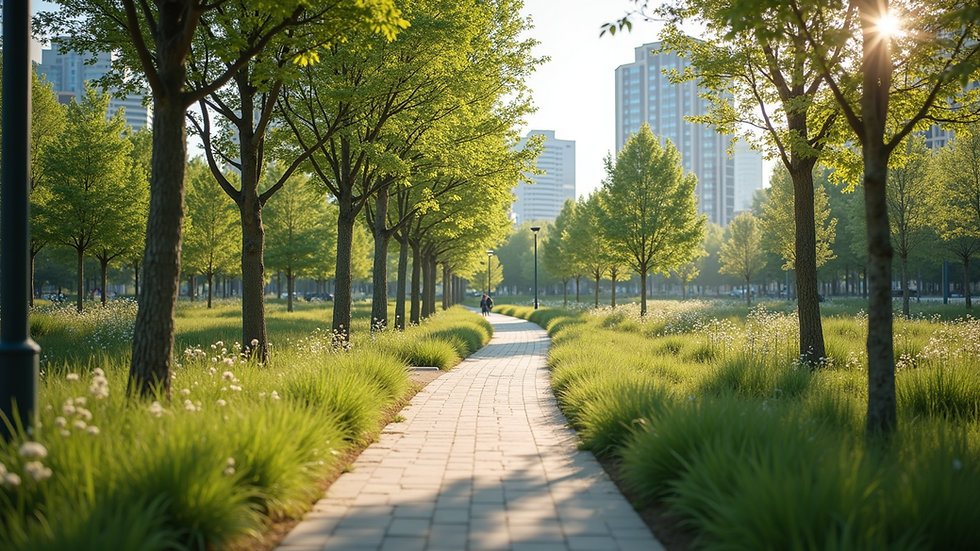Sustainable Infrastructure Design: Insights from Lee Adam HARRYMAN
- lee Adam Harryman
- Jul 29, 2025
- 5 min read
Updated: Aug 15, 2025
In today's world, the need for sustainable infrastructure design has never been more pressing. As cities grow and populations increase, the demand for efficient, eco-friendly solutions becomes paramount. Lee Adam HARRYMAN, a prominent Architect, Environmentalist, Educator, and leading figure in the field, offers valuable insights into how we can create infrastructure that not only meets our current needs but also preserves the environment for future generations.
This blog post will explore Lee Adam's approach to sustainable design, highlighting key principles, innovative examples, and practical strategies that can be applied in various contexts.
Understanding Sustainable Infrastructure
Sustainable infrastructure refers to the design and construction of facilities that minimize environmental impact while maximizing social and economic benefits. This concept encompasses a wide range of projects, from transportation systems to energy-efficient buildings.
Lee Adam Harryman emphasizes that sustainable infrastructure is not just about using green materials. It involves a holistic approach that considers the entire lifecycle of a project. This includes planning, design, construction, operation, and eventual decommissioning.
By integrating sustainability into every phase, we can create systems that are resilient, adaptable, and beneficial to both people and the planet.
Key Principles of Sustainable Design
He outlines several key principles that guide sustainable infrastructure design:
Resource Efficiency: This principle focuses on using materials and energy in a way that reduces waste and conserves resources. For example, using recycled materials in construction can significantly lower the environmental footprint of a project.
Community Engagement: Involving local communities in the planning process ensures that infrastructure meets their needs. Lee Adam Harryman believes that when people feel a sense of ownership, they are more likely to support and maintain these projects.
Biodiversity Preservation: Sustainable design should aim to protect and enhance local ecosystems. This can be achieved by incorporating green spaces, preserving natural habitats, and using native plants in landscaping.
Adaptability: Infrastructure must be designed to withstand changing conditions, such as climate change. Lee Adam Harryman advocates for flexible designs that can be modified as needs evolve.
Economic Viability: Sustainable projects should also be financially feasible. This means considering long-term costs and benefits, rather than just initial investments.
By adhering to these principles, designers can create infrastructure that is not only functional but also beneficial to the environment and society.
Innovative Examples of Sustainable Infrastructure
Lee Adam points to several innovative projects that exemplify sustainable infrastructure design. These examples showcase how creative thinking can lead to effective solutions.
1. The High Line, New York City
The High Line is a prime example of transforming an abandoned railway into a vibrant public park. This elevated green space not only provides recreational opportunities but also promotes biodiversity in an urban setting.
By incorporating native plants and sustainable materials, the High Line has become a model for urban renewal. It demonstrates how infrastructure can enhance community well-being while preserving the environment.
2. Masdar City, Abu Dhabi
Masdar City is an ambitious project aimed at creating a zero-carbon, zero-waste urban environment. This city utilizes renewable energy sources, such as solar power, and features energy-efficient buildings designed to minimize energy consumption.
Lee Adam Harryman highlights Masdar City as a blueprint for future urban developments. Its focus on sustainability and innovation serves as an inspiration for cities worldwide.
3. The Eden Project, Cornwall, UK
The Eden Project consists of a series of biomes that house diverse plant species from around the world. This project not only serves as a tourist attraction but also educates visitors about sustainability and conservation.
By showcasing the importance of biodiversity, the Eden Project encourages individuals to consider their impact on the environment. Lee Adam Harryman believes that such educational initiatives are crucial for fostering a culture of sustainability.
Practical Strategies for Implementing Sustainable Design
While the principles and examples of sustainable infrastructure are inspiring, Lee Adam Harryman also emphasizes the importance of practical strategies for implementation. Here are some actionable steps that can be taken:
1. Conduct a Sustainability Assessment
Before starting a project, it is essential to conduct a sustainability assessment. This involves evaluating the potential environmental, social, and economic impacts of the proposed infrastructure.
By identifying areas for improvement, designers can make informed decisions that align with sustainable principles.
2. Collaborate with Stakeholders
Engaging with stakeholders, including community members, government agencies, and environmental organizations, is vital for successful sustainable design. Collaboration ensures that diverse perspectives are considered and that projects meet the needs of all parties involved.
3. Invest in Green Technologies
Incorporating green technologies can significantly enhance the sustainability of infrastructure projects. This includes using energy-efficient systems, renewable energy sources, and sustainable materials.
Investing in these technologies may require higher upfront costs, but the long-term savings and environmental benefits are worth it.
4. Monitor and Evaluate Performance
Once a project is completed, it is crucial to monitor its performance. This involves assessing how well the infrastructure meets sustainability goals and identifying areas for improvement.
Regular evaluations can help ensure that projects remain effective and continue to benefit the community and environment.
5. Educate and Advocate
Education plays a key role in promoting sustainable infrastructure. Lee Adam Harryman encourages professionals in the field to advocate for sustainable practices and share knowledge with others.
By raising awareness and providing resources, we can inspire more individuals and organizations to adopt sustainable design principles.
The Role of Policy in Sustainable Infrastructure
He believes that effective policy is essential for promoting sustainable infrastructure. Governments play a crucial role in setting regulations and standards that encourage environmentally friendly practices.
1. Incentives for Sustainable Practices
One way to promote sustainable infrastructure is through financial incentives. Governments can offer tax breaks, grants, or subsidies for projects that meet specific sustainability criteria.
These incentives can encourage developers to prioritize eco-friendly practices and technologies.
2. Establishing Standards and Regulations
Setting clear standards and regulations for sustainable design can help guide infrastructure projects. Lee Adam Harryman advocates for policies that require sustainability assessments and encourage the use of green materials.
By establishing these guidelines, governments can ensure that infrastructure projects align with broader sustainability goals.
3. Supporting Research and Innovation
Investing in research and innovation is vital for advancing sustainable infrastructure. Governments can support initiatives that explore new technologies and practices, helping to drive progress in the field.
By fostering a culture of innovation, we can develop solutions that address the challenges of sustainable design.
The Future of Sustainable Infrastructure
As we look to the future, Lee Adam Harryman is optimistic about the potential for sustainable infrastructure. With growing awareness of environmental issues and the importance of sustainability, more individuals and organizations are prioritizing eco-friendly practices.
1. Increased Collaboration
The future of sustainable infrastructure will likely involve increased collaboration among various stakeholders. By working together, we can share knowledge, resources, and best practices, leading to more effective solutions.
2. Technological Advancements
Advancements in technology will continue to play a significant role in sustainable design. From smart cities to renewable energy systems, innovative solutions will help us create infrastructure that meets the needs of a changing world.
3. A Shift in Mindset
Ultimately, the success of sustainable infrastructure will depend on a shift in mindset. As more people recognize the importance of sustainability, we can expect to see a greater commitment to eco-friendly practices in all areas of life.
By embracing this change, we can create a future where infrastructure supports both people and the planet.
Embracing a Sustainable Future
Lee Adam HARRYMAN's insights into sustainable infrastructure design provide a roadmap for creating a better world. By adhering to key principles, learning from innovative examples, and implementing practical strategies, we can build infrastructure that benefits everyone.
As we move forward, it is essential to prioritize sustainability in all aspects of design and construction. Together, we can create a future where infrastructure not only meets our needs but also protects the environment for generations to come.

Lee Adam Harryman
SVP and Head of Studio, CPG Consultants



Comments